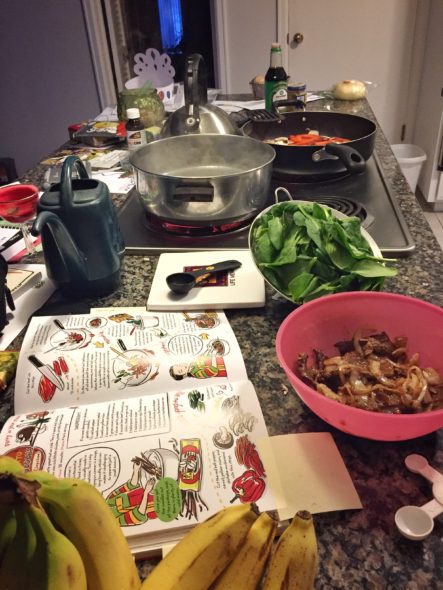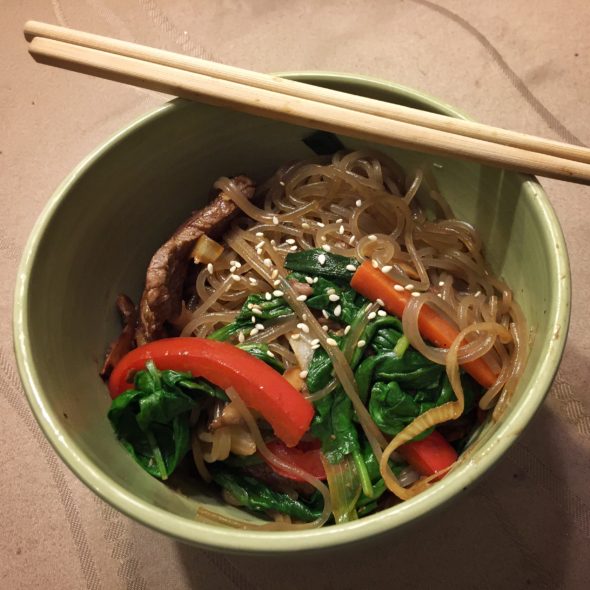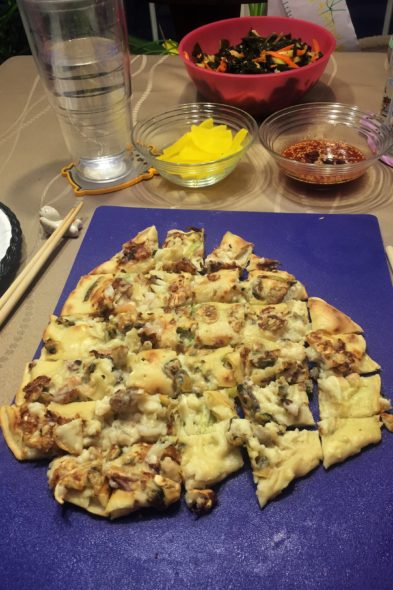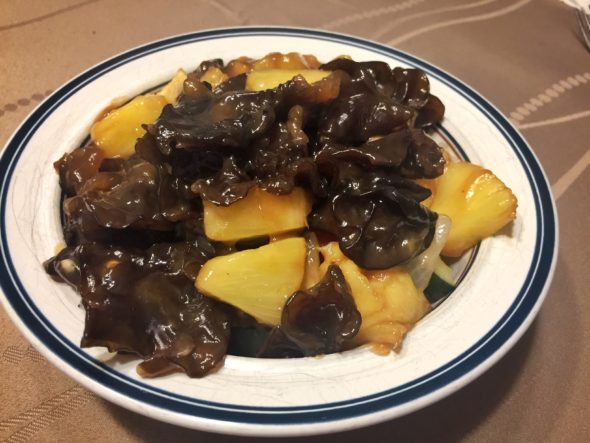To prepare for February’s cooking adventures, I spent some $100 at our favorite Asian grocery / Korean restaurant combo, buying ingredients I couldn’t pronounce. I even had to ask for help finding the last half dozen or so items on my list, like specific kinds of seaweed and dried mushrooms.
But it was worth it. It was so worth it.

As I began my month of Korean cooking, guided by Robin Ha‘s manga-cookbook Cook Korean, I found that I was really stepping out of my comfort zone. I mean, I love Korean food, but I’d never actually made it at home, and what seems fairly commonplace to someone who cooks in a certain style all the time can be a new adventure for someone who doesn’t.
As I earmarked recipes that I wanted to try, I also noted which ones would take more than, say, half an hour to make. Those would be relegated to weekend cooking, or at the very least would need advance prep the night before, as I’m under the gun to keep the evening routine moving along on weeknights. Some recipes required dried ingredients to be soaked; others required an hours-long marinade; still others just needed an especially long prep and cook time.
A note before I get into the actual cooking: Last month, I posted the recipes I was cooking because they were from a small-press, out-of-print cookbook. This month’s cookbook is one I really think people should check out for themselves. Whenever possible, I’ll include a link to the recipe (or one very much like it) on Robin’s tumblr.
1. Spicy Octopus with Rice
2. Tteokbokki (Rice Cakes)
I made these together, for our first home-cooked Korean meal. Making two unfamiliar dishes in tandem was a learning experience: I learned never to do that again.
I also discovered that I didn’t do the best job of purchasing the proper ingredients: I only bought 12oz of octopus instead of the two pounds (32oz) the recipe called for, so I only made a half-recipe.
Also, I accidentally bought “fish cakes” that were actually surimi, or imitation crab, instead of the pressed Korean fish cakes that they serve as side dishes. So, the tteokbokki was missing an ingredient, but it still came out delicious. It’s usually a spicy dish, but since my son isn’t keen on spicy, I took the sweet option that the recipe offered.
Although I kind of felt like I was flying by the seat of my pants at times, with halving the octopus recipe and missing an ingredient in the tteokbokki, my first Korean meal was still a Sunday night success.
3. Bulgogi Dup Bap
The recipe calls for beef that’s pre-cut at a proper thickness for bulgogi. As I had gotten an appropriate cut of beef in my most recent ButcherBox, I decided to just slice it myself.
I need a sous chef. Seriously, for so many of these recipes, the prep work is the bulk of the time involved. Someone who makes Korean food on the regular would probably have many of these ingredients pre-prepped, much like I’ll dice an entire huge onion and keep half in the fridge for when I need it again.
Again, the whole family LOVED this recipe. Apart from the ingredient prep, this was a very simple recipe.
I even tried making it again later on, but I discovered that the marinade seriously does need to be only a few hours, and not overnight; otherwise, the bulgogi gets weird and mushy.
4. Japchae
Not even exaggerating: this recipe turned out better than any japchae I’ve ordered in a restaurant. A+ would make again! My only reminder to myself for next time is to cut the meat not just into thin pieces, but into bite-size pieces.
Plus, I finally remembered to photograph my creation before I devoured it.

5. Haemul Pajeon
6. Seaweed Salad
I know, I said I’d never make two new recipes at once ever again. Well, the seaweed salad was an exception, as all it really called for was reconstituting the dried kelp and combining it with matchstick-cut veggies and a spicy-tangy dressing. Delicious and easy! I’ll definitely make the seaweed salad again, especially considering that I still have a huge bag of seaweed to use up.

The seafood pancake, though… that has a bit of a learning curve associated with it. I’m already no good at flipping pancakes, much less pancakes laden with seafood and scallions, so I attempted a plate-flipping transfer that sort of worked. The pancake also ended up slightly underdone in the middle, but it was still delicious.
If I do try this again in the future, I’ll probably try making several personal-sized pajeon instead of one family-sized one.
7. Tang Su Yuk
This one I modified a bit. The recipe calls for crispy, deep-fried pork (yuk means meat), but the extra-crispy pork bits are honestly not my favorite part of this dish. Instead, I opted to use tofu in lieu of meat. I attempted to deep-fry the tofu, but I used too shallow of a pan and too little oil, so it got messy, and I’ll probably just stick to pan-frying in the future.
This was the recipe that required an overnight soak of wood-ear (black) mushrooms. I’d never cooked with these before, and I was overjoyed to discover that these are the “black fungus” that I love to get at our local hot pot joint! I really need to get more into cooking with different varieties of mushrooms; I’ve never met a mushroom I didn’t like.

I loved this so much I made it again a couple weeks later, then a third time with just the leftover reconstituted mushrooms and sauce.
The verdict? My family loved these recipes so much that we started a shopping list of Korean foods for the next time we stop by the market for dinner (which will hopefully be tonight, actually). Now that I’ve got the hang of a very small subset of Korean cooking, I feel more comfortable with trying other applications along the same lines.